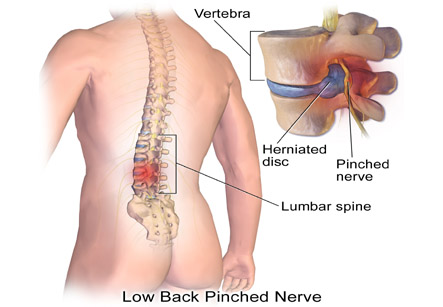Herniated Disc
Introduction
Our spines are made up of 33 bones (vertebrae) which are designed to protect the spinal cord. Gel-filled discs between the bones serve as shock absorbers. The discs also allow mobility while bending forwards and backwards and twisting the back in various directions. These discs are round and flat, with a tough, outer layer (annulus) that surrounds a jellylike material called the nucleus. Thick ligaments attached to the vertebrae hold the pulpy disc material in place. The nucleus tissues located in the center of the disc are sometimes placed under so much pressure that it can cause the annulus to herniate or rupture against one or more of the spinal nerves. This causes pain, numbness, or weakness in the low back, leg or foot. This problem is also called as bulging disk or slipped disc. Herniated discs can occur in any part of the spine. Herniated discs are more common in the lower back (lumbar spine), but also occur in the neck (cervical spine).
Causes
A single excessive strain or injury on the disc may cause it to herniate. However, disc usually degenerates naturally with increasing age, and the ligaments that hold it in place begin to loosen up. As this degeneration progresses, a relatively minor strain or twisting movement can cause a disc to rupture.
We have all the information you need about public and private clinics and hospitals that provide spinal surgery in Iran, Islamic Republic Of with the best quality and lowest possible prices

Symptoms
If the herniated disc is not pressing on a nerve, there may be no pain at all. If it is pressing on a nerve, there may be pain, numbness or weakness in the area of the body to which the nerve supplies.
The doctor may recommend surgery if conservative treatment options, such as physical therapy and medications, do not reduce or end the pain altogether.
In Lumbar spine (lower back): Sciatica is the result of a herniated disc in the lower back. Pressure on one or several nerves that contribute to the sciatic nerve can cause pain, burning, tingling, and numbness which radiates from the buttock into the leg and sometimes into the foot. This pain often is described as sharp and electric shock-like. It may be more severe with standing, walking or sitting.
Cervical spine (neck): Symptoms may include dull or sharp pain in the neck or between the shoulder blades, radiation of to the hand or fingers, or numbness or tingling in the shoulder or arm. The pain may increase with movements of the neck.
Diagnosis
Diagnosis is made by a complete medical history, a physical examination and results of tests, including the following:
1. X-ray, computed tomography scan (CT scan) and Magnetic resonance imaging (MRI): These studies can show the vertebrae, spinal cord, nerve roots and surrounding areas, as well as enlargement, degeneration, and tumors.
2. Myleogram: An X-ray of the spinal canal is taken after injection of a contrast material into the surrounding cerebrospinal fluid spaces. This is done to show pressure on the spinal cord or nerves due to herniated discs, bone spurs or tumors.
3. Electromyogram and Nerve Conduction Studies (EMG/NCS): These tests measure the electrical impulse along nerve roots, peripheral nerves and muscle tissue. This can diagnose ongoing nerve damage, a past injury to nerves or whether there is another site of nerve compression.
Treatment
The initial treatment for a herniated disc usually is conservative. This may include:
1. Bed rest or advise to maintain a low, painless activity level for a few days to several weeks. This helps the spinal nerve inflammation to decrease.
2. Nonsteroidal anti-inflammatory medication if the pain is mild to moderate.
3. An epidural steroid injection may be given under X-ray guidance to direct the medication to the exact level of the disc herniation.
4. Physical therapy. This may include pelvic traction, gentle massage, ice and heat therapy, ultrasound, electrical muscle stimulation, and stretching exercises.
5. Pain medication and muscle relaxants.
Surgery
The doctor may recommend surgery if conservative treatment options, such as physical therapy and medications, do not reduce or end the pain altogether. The surgical options may include:
1. Lumbar laminotomy is a procedure often utilized to relieve leg pain and sciatica caused by a herniated disc. This surgery removes a portion of the vertebra to release the pinched nerves. The bulging disc is removed after this, which is called as discectomy. Spinal fusion often is performed in conjunction with a laminotomy for stability.
2. In more involved cases, a laminectomy may be performed.
3. In artificial disc surgery, an incision is made through the abdomen, and the affected disc is removed and replaced.
4. Cervical Spine laminotomy can be performed, followed by a discectomy. After the disc is removed, the spine is stabilized by using a cervical plate and screws (instrumentation), and, often, spinal fusion.